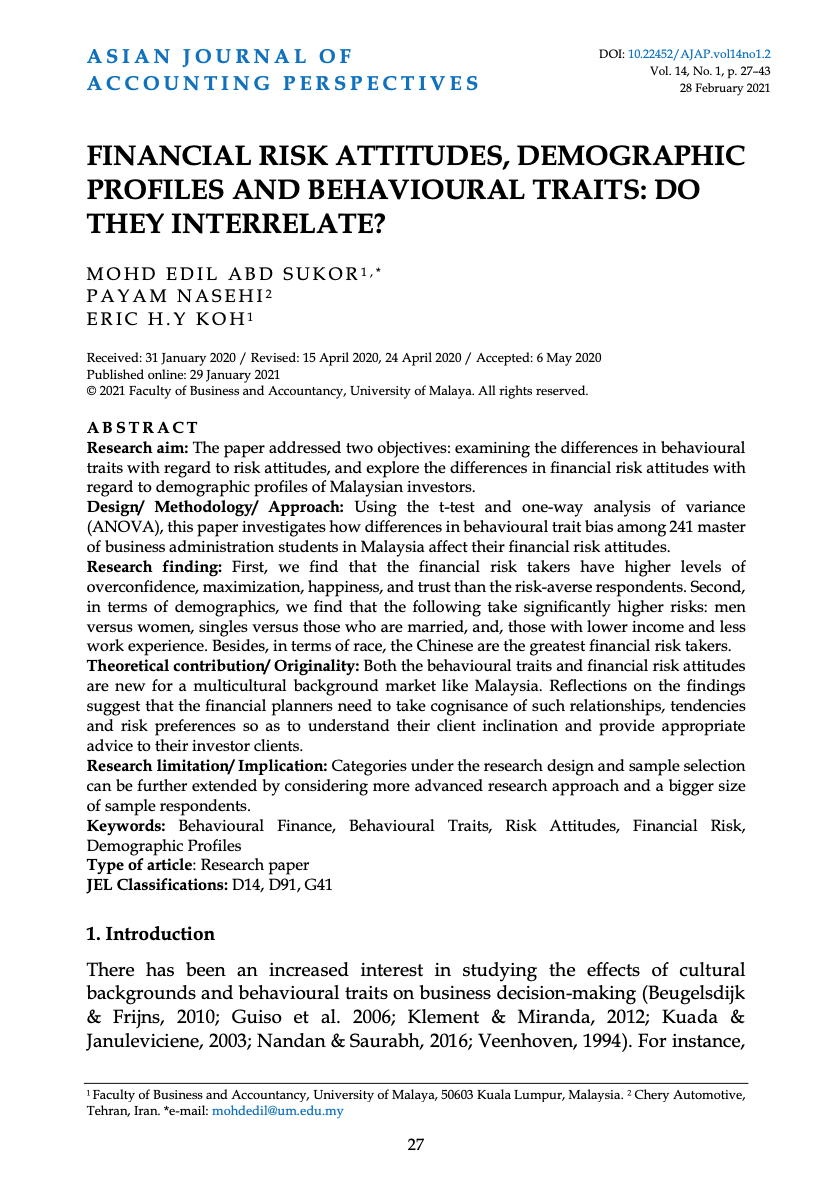Financial risk attitudes, demographic profiles, and behavioural traits: Do they interrelate?
Main Article Content
Abstract
Research aim: The paper addressed two objectives: examining the differences in behavioural traits with regard to risk attitudes, and explore the differences in financial risk attitudes with regard to demographic profiles of Malaysian investors.
Design/ Methodology/ Approach: Using the t-test and one-way analysis of variance (ANOVA), this paper investigates how differences in behavioural trait bias among 241 master of business administration students in Malaysia affect their financial risk attitudes.
Research finding: First, we find that the financial risk takers have higher levels of overconfidence, maximization, happiness, and trust than the risk-averse respondents. Second, in terms of demographics, we find that the following take significantly higher risks: men versus women, singles versus those who are married, and, those with lower income and less work experience. Besides, in terms of race, the Chinese are the greatest financial risk takers.
Theoretical contribution/ Originality: Both the behavioural traits and financial risk attitudes are new for a multicultural background market like Malaysia. Reflections on the findings suggest that the financial planners need to take cognisance of such relationships, tendencies and risk preferences so as to understand their client inclination and provide appropriate advice to their investor clients.
Research limitation/ Implication: Categories under the research design and sample selection can be further extended by considering more advanced research approach and a bigger size of sample respondents.
Keywords: Behavioural Finance, Behavioural Traits, Risk Attitudes, Financial Risk, Demographic Profiles
Type of article: Research paper
JEL Classifications: D14, D91, G41
Received: 31 January 2020
Revised: 15 April 2020, 24 April 2020
Accepted: 6 May 2020
Published online: 29 January 2021
Downloads
Article Details
License
The Asian Journal of Accounting Perspectives (AJAP) articles are published under a licence equivalent to the Creative Commons Attribution-NonCommercial-NoDerivs License (CC BY-NC-ND). The licence allows users to copy, distribute, and transmit an article as long as the author is attributed. The article is not used for commercial purposes. The work is not modified or adapted in any way.
Copyright
Authors are required to sign the Exclusive License to Publish agreement upon publication in the AJAP. The agreement grants the Publisher (Faculty of Business and Accountancy, Universiti Malaya) to publish and disseminate the articles.
Open Access
Articles published in the AJAP are digital, online, free of charge, and free of most copyright and licensing restrictions.
Article Processing Charge
Articles publish in AJAP is free submission, production and publication charges. However, all accepted articles are required for language editing. The AJAP officially appointed and outsourced proofreader will conduct this process, and the authors will cover the cost. AJAP does not profit from this process and transaction.
References
Albaity, M., & Rahman, M. (2012). Behavioural finance and Malaysian culture. International Business Research, 5(11), 65-76. https://doi.org/10.5539/ibr.v5n11p65
Albaity, M. S., & Rahman, M. (2012). Gender, ethnicity, and religion and investment decisions: Malaysian evidence. Journal of Sociological Research, 3(2), 502-519. https://doi.org/10.5296/jsr.v3i2.2649
Arianti, B. F. (2018). The influence of financial literacy, financial behavior and income on investment decision. Economics and Accounting Journal, 1(1), 1-10. http://dx.doi.org/10.32493/eaj.v1i1.y2018.p1-10
Bailard, T., Biehl, D., & Kaiser, R. W. (1986). Personal Money Management, Chicago: Science Research Associates.
Baker, H. K., Kumar, S., Goyal, N., & Gaur, V. (2019). How financial literacy and demographic variables relate to behavioral biases. Managerial Finance, 45(1), 124-146. https://doi.org/10.1108/MF-01-2018-0003
Barnewall, M. M. (1987). Psychological characteristics of the individual investor. ICFA Continuing Education Series, 1987(2), 62-71.
Beugelsdijk, S., & Frijns, B. (2010). A cultural explanation of the foreign bias in international asset allocation. Journal of Banking and Finance, 34(9), 2121-2131. https://doi.org/10.1016/j.jbankfin.2010.01.020
Blaine, B., & Crocker, J. (1993). Self-esteem and self-serving biases in reactions to positive and negative events: An integrative review. In Self-esteem (pp. 55-85). Springer US.
Blake, D, Cannon, E., & Wright, D. (2019). Quantifying loss aversion: evidence from a UK population survey. Discussion Paper PI-1912, The Pensions Institute, Cass Business School: London.
Bontempo, R. N., Bottom, W. P., & Weber, E. U. (1997). Cross‐cultural differences in risk perception: A model‐based approach. Risk Analysis, 17(4), 479-488. https://psycnet.apa.org/doi/10.1111/j.1539-6924.1997.tb00888.x
Burks, S. V., Carpenter, J. P., Goette, L., & Rustichini, A. (2009). Cognitive skills affect economic preferences, strategic behaviour, and job attachment. Proceedings of the National Academy of Sciences, 106(19), 7745-7750. https://doi.org/10.1073/pnas.0812360106
Byrnes, J. P., Miller, D. C., & Schafer, W. D. (1999). Gender differences in risk taking: A meta-analysis. Psychological Bulletin, 125(3), 367-383. https://psycnet.apa.org/doi/10.1037/0033-2909.125.3.367
Chen, C., & Handley-Schachler, M. (2016). Investigation of variation between risk attitude and investment biases. The International Review of Financial Consumers, 1(1), 57-80.
Dickason, Z., & Ferreira, S. (2018). Establishing a link between risk tolerance, investor personality and behavioural finance in South Africa. Cogent Economics and Finance, 6(1), 1-13. https://doi.org/10.1080/23322039.2018.1519898
Diener, E., Suh, E. M., Lucas, R. E., & Smith, H. L. (1999). Subjective well-being: Three decades of progress. Psychological Bulletin, 125(2), 276-302. https://doi.apa.org/doi/10.1037/0033-2909.125.2.276
Dulebohn, J. H., & Murray, B. (2007). Retirement savings behaviour of higher education employees. Research in Higher Education, 48(5), 545-582. https://doi.org/10.1007/s11162-006-9038-z
Dyer, J. S., & Sarin, R. K. (1982). Relative risk aversion. Management Science, 28(8), 875-886.
Eduniversal (2015), Business School University Ranking in Malaysia 2015. Available at: http://www.eduniversal-ranking.com
Fry, T. R., Mihajilo, S., Russell, R., & Brooks, R. (2008). The factors influencing saving in a matched savings program: Goals, knowledge of payment instruments, and other behaviour. Journal of Family and Economic Issues, 29(2), 234-250. https://doi.org/10.1007/s10834-008-9106-y
Gorman, M., & Sahlman, W. A. (1989). What do venture capitalists do? Journal of Business Venturing, 4(4), 231-248. https://doi.org/10.1016/0883-9026(89)90014-1
Guiso, L., Sapienza, P., & Zingales, L. (2006). Does culture affect economic outcomes? Journal of Economic Perspectives, 20(2), 23-48. https://doi.org/10.1257/jep.20.2.23
He, J. (2020). Risk attitude, financial knowledge and commercial life insurance needs. Modern Economy, 11(1), 185-199.
Jonsson, S., Söderberg, I. L., & Wilhelmsson, M. (2017). An investigation of the impact of financial literacy, risk attitude, and saving motives on the attenuation of mutual fund investors’ disposition bias. Managerial Finance, 43(3), 282-298. https://doi.org/10.1108/MF-10-2015-0269
Kishan, K., & Alfan, E. (2019). Malaysian individual investors: What are the factors that influence their financial statement usage? Asian Journal of Accounting Perspectives, 12(1), 22-48. https://doi.org/10.22452/AJAP.vol12no1.2
Klement, J., & Miranda, R. E. (2012). Kicking the habit: How experience determines financial risk preferences. The Journal of Wealth Management,15(2), 10-25. https://doi.org/10.3905/jwm.2012.15.2.010
Koebel, B., Schmitt, A., & Spaeter, S. (2015). Do self-theories explain overconfidence and financial risk taking? A field experiment. Document de Travail no. 2015 – 04, Bureau d’economie theorique et appliquee (BETA) UMR7522.
Koh, E. H. Y (2018). Chinese-ness legacy? A study of ethnic Chinese entrepreneur-controlled banks in Malaysia. International Journal of China Studies, 9(1), 49-66.
Kuada, J. E., & Janulevièienë, R. (2003). Perspectives on female entrepreneurs: A comparative review of studies in the west and the transitional economies. Transformations in Business and Economics, 2(4), 109-122.
Michenaud, S. & Solnik, B. (2008). Applying regret theory to investment choices: Currency hedging decisions. Journal of International Money and Finance, 27, 677–694. https://doi.org/10.1016/j.jimonfin.2008.03.001
Nandan, T., & Saurabh, K. (2016). Big-five personality traits, financial risk attitude and investment intentions: study on Generation Y. International Journal of Business Forecasting and Marketing Intelligence, 2(2), 128-150.
New Straits Times (2019). Strong GDP growth continues to highlight Malaysia's resilience. Retrieved from https://www.nst.com.my/business/2019/08/513518/strong-gdp-growth-continues-highlight-malaysias-resilience-mof
Nofsinger, J. R., Patterson, F. M., & Shank, C. A. (2018). Decision-making, financial risk aversion, and behavioral biases: The role of testosterone and stress. Economics and Human Biology, 29, 1-16. https://doi.org/10.1016/j.ehb.2018.01.003
Olsen, R. (2012). Trust: the underappreciated investment risk attribute. Journal of Behavioral Finance, 13(4), 308-313. https://doi.org/10.1080/15427560.2012.735728
Otuteye, E., & Siddiquee, M. (2019). Underperformance of Actively Managed Portfolios: Some Behavioral Insights. Journal of Behavioral Finance, 21(1), 1-17. https://doi.org/10.1080/15427560.2019.1692210
Pan, C., & Statman, M. (2012). Questionnaires of risk-tolerance, regret, overconfidence, and other investor propensities. Journal of Investment Consulting, 13(1), 54-63.
Park, E., & Yao, R. (2016). Financial risk attitude and behavior: Do planners help increase consistency? Journal of Family and Economic Issues, 37(4), 624-638. https://doi.org/10.1007/s10834-015-9469-9
Phoenix, C. H., Goy, R. W., Gerall, A. A., & Young, W. C. (1959). Organizing action of prenatally administered testosterone propionate on the tissues mediating mating behaviour in the female guinea pig 1. Endocrinology, 65(3), 369-382. https://doi.org/10.1210/endo-65-3-369
Pompian, M. (2012). Behavioral finance and investor types. Private Wealth Management Feature Articles, 2012(1), 1-3.
Redding, S. G., & Hsiao, M. (1990). An empirical study of overseas Chinese managerial ideology. International Journal of Psychology, 25, 629-641. https://doi.org/10.1080/00207599008247917
Rieger, M. O., Wang, M., & Hens, T. (2014). Risk preferences around the world. Management Science, 61(3), 637-648. http://dx.doi.org/10.1287/mnsc.2013.1869
Ryff, C. D. (1991). Possible selves in adulthood and old age: a tale of shifting horizons. Psychology and Aging, 6(2), 286-295. https://doi.org/10.1037//0882-7974.6.2.286
Sarin, R. K., & Weber, M. (1993). Effects of ambiguity in market experiments.Management science, 39(5), 602-615. http://dx.doi.org/10.1287/mnsc.39.5.602
Statman, M. (2008). Countries and culture in behavioural finance. In CFA Institute Conference Proceedings Quarterly, 25(3), 38-44.
Statman, M. (2015). Culture in risk, regret, maximization, social trust, and life satisfaction. Journal of Investment Consulting, 16(1), 20-30.
Tanaka, T., Camerer, C. F., & Nguyen, Q. (2010). Risk and time preferences: linking experimental and household survey data from Vietnam. The American Economic Review, 100(1), 557-571. http://dx.doi.org/10.1257/aer.100.1.557
Veenhoven, R., & Coworkers (1994). World database of happiness: Correlates of happiness. Erasmus University NL.
Vieider, F. M., Chmura, T., & Martinsson, P. (2012). Risk attitudes, development, and growth: Macroeconomic evidence from experiments in 30 countries (No. SP II 2012-401). Discussion Paper, Social Science Research Center Berlin (WZB), Research Area Markets and Politics, WZB Junior Research Group Risk and Development.
Weber, E. U. and Johnson, E. J. (2006). Constructing preferences from memory. In The Construction of Preference (pp. 397-410). Cambridge University Press US.
Wu, W. Y., Lu, H. Y., & Chen, L. T. (2011). The moderating roles of involvement and heuristics on advertising effectiveness: A study of financial advertisements. Asian Journal of Business and Accounting, 4(1), 1-21.

